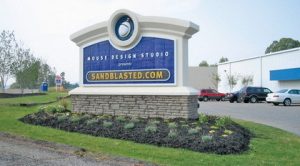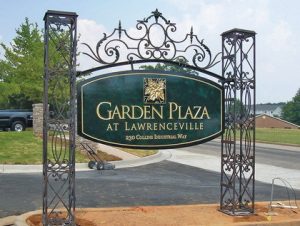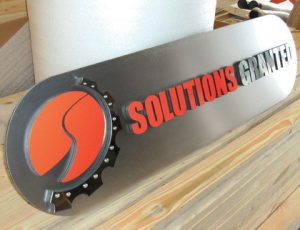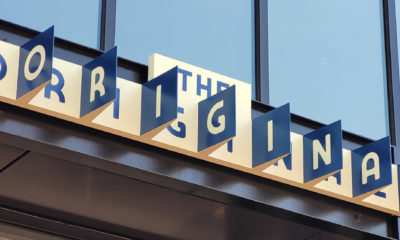Dimensional Signs
Built for Speed
Mouse Design Studio
Published
16 years agoon
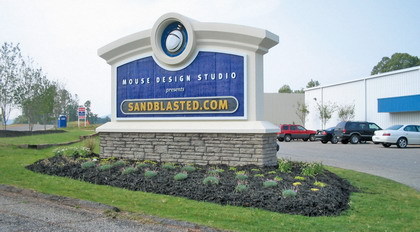
It’s a harsh, but undeniable, reality – signshops must adapt themselves to 21st-century business models. Sign-industry entrepreneurs must become more web-savvy and efficient with their marketing and processes. Often, this means less time cold-calling and pounding the pavement and, instead, optimizing a website that efficiently conveys a signshop’s capabilities.
Mouse Design Studio (Cumming, GA) has mastered the 21st-century economy. Beginning with sandblasting signage more than a decade ago, the shop has created niche websites that cater to several sign types. Rather than throwing its energies into the arduous process of unearthing potential customers, Mouse lets its array of sites do the work and bring customers to them. Wade Parker, the company’s president, has overseen the shop’s transformation from a garage enterprise to a booming, full-service facility.
Point and click
A native of Wrightsville Beach, NC, Parker served two years in the U.S. Coast Guard before he graduated from North Carolina State University with a bachelor’s degree in physics in 1994. He moved to Atlanta the day he graduated. However, when he considered long-term career prospects, he decided the sign business offered a more professionally fulfilling alternative.
“Looking ahead, with a physics degree, my choices were basically to teach physics at the high-school or collegiate level, or to wear a white coat and work in a lab,” Parker said. “I have a passion for art – painting, sculpting, anything using my hands – so I minored in graphic design. The sign industry offered a challenge that complemented my interests, and I decided it offered a more fulfilling career opportunity.”
Parker learned the trade by working at small, family-owned shops and franchises in the metro-Atlanta area. After he’d saved enough money and developed the ambition to run his own business, Parker sensed the then-emerging importance of the Internet and founded www.sandblasted.com as an enterprise under his umbrella company, Wimbley Inc.
AdvertisementHe began running his business out of his house and blasting his signs in a homemade booth on his back deck. Soon, the World Wide Web helped attract signshops looking for a reliable subcontractor, and he began hiring staff to help design and fabricate the signs – as well as process the growing pool of online requests.
Next, Parker procured a modest, 900-sq.-ft. storefront, which allowed him to set up a proper sandblasting booth. With an established shop space, he also purchased a CNC router and inkjet printer and began fabricating other types of signs. Naturally, this generated more traffic than a single website could handle, so expanded his business and launched the following websites:
• www.vgroovesigns.com touts the shop’s CNC-routed signs;
• www.signportfolio.com maintains an updated photography gallery of the company’s cross-section of projects;
• www.signmonument.com targets commercial and residential developers, churches and other property owners and managers in need of a large, prominent sign that grabs motorists’ attention;
Advertisement• www.lobbydisplays.net serves the interior and ADA-graphics market and custom, dimensional interior displays;
• www.militaryshields.com offers dimensional plaques and medallions for government facilities and installations; and,
• www.mousedesignstudio.com while functioning as an all-purpose portal to the company’s myriad websites, also markets the company’s web, print and interactive design.
Parker selected the company’s name because the computer mouse is the one common thread that links the broad sign-market swath the shop covers. Initially, the company enlisted a service provider to manage its web traffic. However, by 2000, he knew he would have to bring site management inhouse to meet their needs.
“Sandblasted.com routinely receives an average of 500 unique site visits per hour, and our other sites attract 100 to 200 visitors per day,” Parker explained. “We weren’t receiving the support we needed from our Internet service provider, so we bought a network of servers and brought web hosting inhouse to keep up with our volume.”
He cites efficiency as a primary motivation for operating a web-based business: “We’ve structured ourselves to be completely data-driven. We observe trends in successful customer orders through the websites, and outfit our shops with staff, materials and equipment to meet demand.”
AdvertisementOn each site, the company has outlined the process – the types of files it accepts, the tools and materials used to produce each job – and the strengths and weakness of each material if multiple options exist, such as wood vs. HDU for sandblasted signage – and its decoration and finishing techniques.
Parker said, “We think it’s important to explain as much as we can about our process as early as we can. This helps our customers have confidence in our product and process knowledge, and it prevents us from having to spend countless hours answering the same questions.”
The company had a prior arrangement with Google to execute a pay-per-click campaign. The $15,000 to $20,000 monthly investment proved favorable as Mouse’s monthly revenue soared from $100,000 to approximately $500,000, but, as the market became increasingly saturated with keyword-driven campaigns, Parker discontinued the arrangement.
“It’s important to build your brand, but the return on investment has to be there,” he said.
A nimble shop
Mouse Design Studio’s dynamic web presence wouldn’t matter if it couldn’t handle production demands. After having temporarily upgraded to a 5,000-sq.-ft. facility, the company now has all necessary amenities with a 37,000-sq.-ft. facility and a 25-person staff.
Showing a light-year’s progression from Parker’s deck sandblaster, his team’s enclosed blasting booth now measures 27 x 12 x 9 ft. – the exact dimensions of a standard semi-trailer. He also outfitted his shop with two |2085| and one MultiCam Inc. CNC routers – Parker refers to the latter, 7 x 14-ft. version as “the Genghis Khan of routers.”
Effective CNC router operations require following two simple rules: Keep it clean, and measure twice before cutting once. Parker said, “Make sure files are accurately set up, and always make a test run before loading the stock and running the job. And you have to keep your machine well maintained so it works and makes money for you.”
The shop also implements two fully automated spraybooths, three Roland DGA Corporation VersaCamm printer/plotters, metal-forming equipment and the requisite hand tools.
Cases in point
A unique Mouse Design’s project involved creating a gateway sign for a business-park development
in Lawrenceville, GA. The property owner wanted to convert a four-poster, wrought-iron bed frame into the sign’s bracket frame. Fabricators meticulously dissembled the bed frame into several components and creatively reshaped it with a MIG welder – the headboard became the overhead bracket, and the posters became the frame.
Mouse fabricated the sign by assembling layers of PVC atop an HDU panel faux-finished with a coating that emulates green marble, gold automotive enamel and a UV sealant to resemble the color and motif of the property’s leasing-office countertops, furniture and fixtures, Parker said.
The company’s improvisational abilities were also tested when Solutions Granted, a Washington, D.C.-based IT firm, requested a distinctive foyer sign. Against a brushed, stainless-steel base panel, fabricators installed a mirror-finished, aluminum arc with hex-head screws and, for the logo and letters, affixed ½-in.-thick, CNC-routed, black PVC decorated with fire-red 1Shot® lettering enamel.
Parker said, “This project was a classic example of mixing materials and substrates to achieve a successful solution.”
Growth opportunities
Rather than focusing purely on the bottom line, or projecting personal-growth objectives onto his career, Parker focuses his company around one goal – helping other small businesses like his own.
“It’s a proven fact that 90% of all new businesses fail in their first year, and it’s unfortunate when someone with drive and a good idea fails,” he said. “While a sign won’t do anything for a business owner’s plan or management, it can play a very significant role in projecting a positive corporate image.”
Although some markets have decreased, such as print-media advertising, Parker said Mouse has more than compensated for that downturn by diversifying his sign products and expanding the company’s web-design capacity.
“Developing a web presence is a beast unto itself,” Parker explained. “You have to account for all future upgrades and functionality, or start from scratch when these changes happen. Lessons learned have enabled us to become experts and offer a marketable service.
He estimates that web design generates 8% of our company’s revenue, and noted it as an especially efficient and profitable revenue stream because there are no costs of goods sold. Parker continued, “You don’t have to order and warehouse any raw materials. Once the code has been written and posted, a website keeps working without sick days or complaints.”
Of course, when virtually all of your signs are transported to distant customers, logistics loom as a key concern. To protect the signs, Parker said his shop builds protective “coffins.” The process entails wrapping the signs in a plastic sheath, which is then enveloped in insulation foam, plywood and a pine “skeleton.”
Understandably, larger signs present the most challenges. Parker said, “We’ve taken measurements of every style of truck-door opening and cabin depth for every national carrier. They’re all different, which can prove challenging to accommodate. We’d prefer not to ship signs to customers in pieces, but sometimes this is a necessary alternative to hiring a flatbed truck, which costs three times more.”
For smaller shops, or those new to the industry, Parker recommends a freight broker because such services provide a discount rate without requiring high freight volume. “Their small markup pays for itself if there’s a claim to handle,” Parker said.
One route Parker doesn’t foresee his shop following is electronic digital signage (EDS): “Right now, we tell our customer we’ll produce every type of sign except electrical. [EDS] components are entirely fabricated overseas, and it’s likely that would be the first segment of business we’d lose to competitors abroad.”
As for the shop’s future direction, Parker said it’s up to his customers to help him determine the shop’s direction – or going with the flow, as he describes it. “We’ve learned to be adaptable,” Parker said. “We’ve shipped sign systems to Alaska, Germany, Singapore and other faraway points around the world. If you have the tools and the motivation, you can accomplish anything.”

SPONSORED VIDEO
Introducing the Sign Industry Podcast
The Sign Industry Podcast is a platform for every sign person out there — from the old-timers who bent neon and hand-lettered boats to those venturing into new technologies — we want to get their stories out for everyone to hear. Come join us and listen to stories, learn tricks or techniques, and get insights of what’s to come. We are the world’s second oldest profession. The folks who started the world’s oldest profession needed a sign.
You may like

6 Sports Venue Signs Deserving a Standing Ovation

Hiring Practices and Roles for Women in Sign Companies

Avery Dennison Adopts Mimaki Printer for Traffic Sign Print System
Subscribe

Bulletins
Get the most important news and business ideas from Signs of the Times magazine's news bulletin.
Most Popular
-

 Tip Sheet3 days ago
Tip Sheet3 days agoAlways Brand Yourself and Wear Fewer Hats — Two of April’s Sign Tips
-

 Business Management1 week ago
Business Management1 week agoWhen Should Sign Companies Hire Salespeople or Fire Customers?
-

 Women in Signs2 weeks ago
Women in Signs2 weeks ago2024 Women in Signs Award Winners Excel in Diverse Roles
-

 Real Deal4 days ago
Real Deal4 days agoA Woman Sign Company Owner Confronts a Sexist Wholesaler
-

 Editor's Note1 week ago
Editor's Note1 week agoWhy We Still Need the Women in Signs Award
-

 Line Time2 weeks ago
Line Time2 weeks agoOne Less Thing to Do for Sign Customers
-

 Product Buying + Technology1 week ago
Product Buying + Technology1 week agoADA Signs and More Uses for Engraving Machines
-

 Women in Signs4 days ago
Women in Signs4 days ago2024 Women in Signs: Megan Bradley
